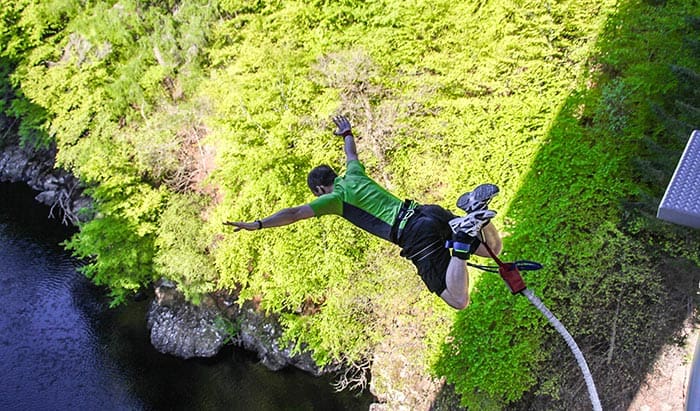Bungee jumping, an adrenaline-pumping activity, often conjures images of exhilarating freefalls and breathtaking views. However, before taking the plunge, it’s crucial to consider the potential risks involved, especially concerning your spinal health. The sudden deceleration and forceful rebound inherent in bungee jumping can place significant stress on the back, potentially leading to injury. Understanding these risks and taking necessary precautions is paramount for a safe and enjoyable experience. So, can bungee jumping hurt your back? Let’s delve into the specifics.
Understanding the Forces Involved
Bungee jumping involves a rapid acceleration followed by an abrupt deceleration. This sudden change in momentum generates significant forces on the body, particularly the spine. These forces can compress the vertebrae, strain muscles, and even damage ligaments. The impact is amplified if the jumper has pre-existing back conditions or poor core strength.
Specific Risks to the Back
Vertebral Compression Fractures: The sudden compression can cause small fractures in the vertebrae, especially in individuals with osteoporosis or weakened bones.
Muscle Strains and Sprains: The muscles and ligaments supporting the spine can be overstretched or torn due to the forceful impact.
Disc Herniation: The intervertebral discs, which act as cushions between the vertebrae, can be damaged or herniated under extreme pressure.
Exacerbation of Existing Conditions: Individuals with pre-existing back pain, scoliosis, or other spinal conditions are at a higher risk of experiencing worsened symptoms.
Factors Influencing the Risk
Several factors can influence the likelihood of back injury during bungee jumping:
Jumper’s Weight and Physical Condition: Heavier individuals and those with poor core strength are at greater risk.
Bungee Cord Elasticity and Length: A poorly calibrated cord can result in a more jarring impact.
Jumping Technique: Improper body positioning during the jump can increase the stress on the spine.
Pre-existing Back Conditions: Individuals with pre-existing back problems should consult a doctor before bungee jumping.
It’s important to note that reputable bungee jumping operators prioritize safety and employ various measures to minimize risks. These measures include using high-quality equipment, providing thorough safety briefings, and carefully assessing each jumper’s suitability for the activity. However, even with these precautions, the inherent risks associated with bungee jumping remain.
FAQ: Bungee Jumping and Back Pain
Here are some frequently asked questions about the potential for back pain after bungee jumping:
- Q: Is bungee jumping safe for my back? A: It depends on your individual health and pre-existing conditions. Consult with your doctor before participating.
- Q: What are the common back injuries from bungee jumping? A: Muscle strains, sprains, vertebral compression fractures, and disc herniation are possible.
- Q: How can I minimize the risk of back injury? A: Ensure the operator is reputable, listen carefully to safety instructions, and maintain good core strength.
- Q: What should I do if I experience back pain after bungee jumping? A: Seek medical attention immediately.
Comparative Table: Potential Back Injuries
| Injury Type | Severity | Likelihood (General Population) |
|---|---|---|
| Muscle Strain | Mild to Moderate | Relatively High |
| Vertebral Compression Fracture | Moderate to Severe | Lower (Higher in individuals with osteoporosis) |
| Disc Herniation | Moderate to Severe | Lower (Higher with pre-existing disc issues) |
Ultimately, the decision to participate in bungee jumping is a personal one. Weighing the potential risks against the thrill of the experience is crucial. If you have any concerns about your back health, consulting with a medical professional is strongly recommended. Remember, prioritizing your well-being is paramount. Therefore, before you consider taking the leap, remember that understanding the potential impact on your spine is crucial, and that’s why it’s important to ask yourself: can bungee jumping hurt your back?
Tips for a Safer Jump
Even if you’re cleared for bungee jumping, there are steps you can take to further minimize the risk of back injury:
- Strengthen Your Core: A strong core provides stability and support for your spine, reducing the impact of the jump. Engage in exercises like planks, bridges, and abdominal crunches regularly.
- Listen to the Safety Briefing: Pay close attention to the instructions provided by the bungee jumping operator. They will guide you on proper body positioning and techniques to minimize stress on your back.
- Communicate with the Operator: Inform the operator of any pre-existing back conditions or concerns you may have. They can adjust the jump setup or provide additional guidance to accommodate your needs.
- Choose a Reputable Operator: Research and select a bungee jumping operator with a proven track record of safety and experience. Look for certifications, positive reviews, and well-maintained equipment.
- Avoid Jumping When Fatigued: Jumping when tired can compromise your coordination and increase the risk of injury. Ensure you are well-rested and alert before participating.
Alternative Thrill-Seeking Activities
If you’re concerned about the potential risks of bungee jumping, there are other adrenaline-pumping activities that may be less stressful on your back:
- Skydiving: While skydiving involves a freefall, the descent is more gradual and controlled than bungee jumping, reducing the impact on the spine.
- Zip-lining: Zip-lining offers a thrilling experience with minimal impact on the body. You are suspended in a harness and glide along a cable, enjoying scenic views.
- Rock Climbing: Rock climbing challenges your physical and mental strength while providing a full-body workout. It can improve core stability and coordination, but it’s important to start with beginner-level climbs and proper instruction.
- White Water Rafting: Navigating rapids in a raft can be an exhilarating adventure. Choose a rafting trip that matches your fitness level and experience.
Ultimately, the best way to protect your back is to make informed decisions and prioritize your safety. Consider your individual health, the potential risks involved, and the precautions you can take. There are many ways to experience the thrill of adventure without compromising your well-being. Remember to listen to your body and choose activities that align with your physical capabilities. Enjoy the adventure responsibly!

